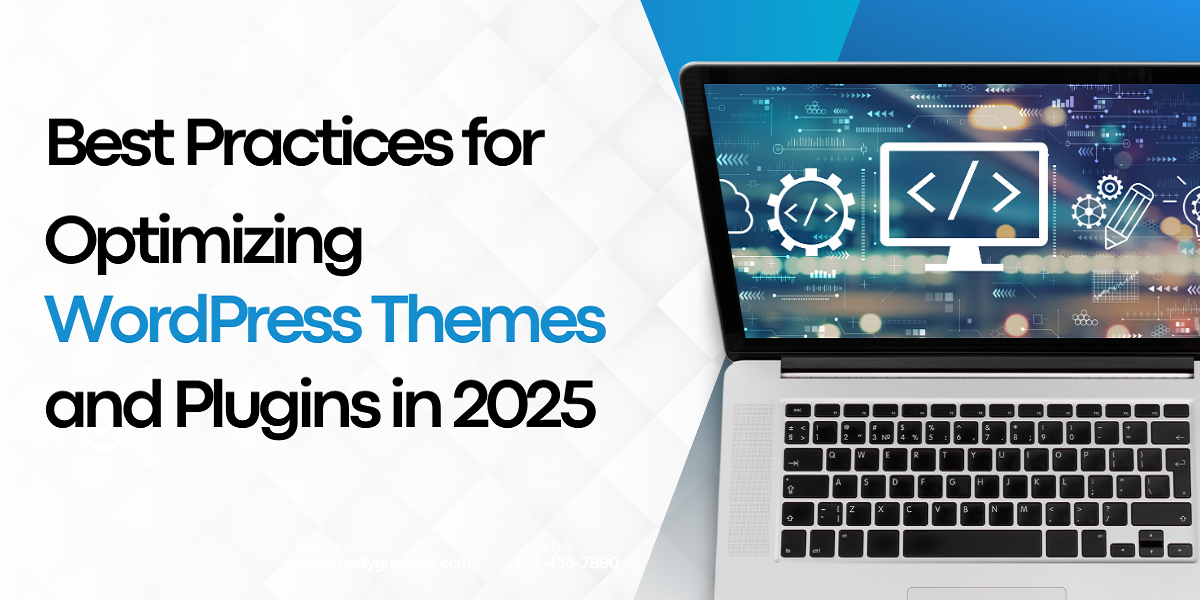
In 2025, WordPress gives its users more customization options but it is important to manage your website optimally. If you have a personal blog, online shop, or a business site, keep in mind a slow or poorly optimized system will only spoil your online image.
Let’s discuss the most effective ways of optimizing themes and plugins in WordPress to improve your site’s functionality and performance.
Website optimization is not an optional task—it is a must. Your chosen market is most probably the trickiest one yet, and the speed, security, and overall performance of your website can make or break your chances on the internet.
Here are some of the reasons as to why optimizing your WordPress themes and plugins should be one of your primary goals:
User Experience (UX): Websites that take longer to open, attract more frustration than conversions from people and end up having higher bounce rates. If a website takes a long time to load, visitors are likely to abandon it which negatively affects both traffic and sales.
Search Engine Rankings: Today, Google's ranking algorithm considers page load speed, mobile optimization, and secure browsing as vital elements to observe due to the website’s SEO. So, a well optimized and fast site is non negotiable.
Mobile Traffic: For people whose primary access to the internet is through mobile devices, it is imperative that your WordPress site is mobile friendly, for example, rapid load times as well as mobile responsiveness are necessary, since they can retain users.
Conversion Rates: If your website is optimized, it will help improve performance metrics of your site, including higher conversions. A faster site improves the chances of visitors subscribing to the site or becoming paying clients.
To put it more simply, remember concepts such as optimization have a direct relationship with your performance so it is necessary to know and apply the relevant best practices. Now let's have a closer look at how to optimize your WordPress themes and plugins to meet current objectives!
Your first step towards optimization is to choose the right theme for your WordPress website and that’s why it is really important.
This is what to consider:
Themes That Don’t Compromise on Performance: A lot of WordPress themes are sold with high end integrations that you may never use, such as background videos or other unnecessary pointers. These elements can hamper the speed of your web page depending on how they were coded. Go for a theme that is optimized for both speed and performance.
Design Responsive and Mobile Friendly: Because there are more and more people browsing over mobile these days, it’s a must for websites to have responsive themes. It helps to provide a good user experience because a responsive website adjusts to all screen sizes.
SEO-Friendly Themes: Templates that are designed with SEO features such as faster loading speed, schema and clean HTML code will help search engines to index your website effectively. Google, and other search engines, will favor your site more with SEO-oriented themes.
Customization & Compatibility: Select templates that allow a little bit of wiggle room so your website aligns with your brand visually. Make sure the template you select is compatible with common page builders like Elementor or WPBakery. This will give you the necessary flexibility to make it a lot easier to build your website without the need to check if every component can work together.
Regular Updates & Support: It is important to pick a template that is consistently updated and supported. This will help guarantee that the theme doesn’t become obsolete and impacts the performance or security of the site in a negative manner.
Now that you know what template to use, it is important to fine-tune it for better performance. Here’s how:
Minimize HTTP Requests: For every webpage that you have, there is a specific server that contains the resources. Each of these servers can contain images, CSS files, or JavaScript. Your site will send a request for these resources to the server every time the page is refreshed. Each one of these requests can increase the time it takes for your webpage to load. Minimize the number of requests by reducing the number of scripts in use, merging any existing CSS files, and taking advantage of async loading the JavaScript.
Implement Caching: One of the best ways to speed up your website is through caching. When caching is enabled, static files (like HTML, CSS, and images) are stored locally in the user's browser or a server. This reduces the need to reload the same resources every time a user visits your website. You can use caching plugins like W3 Total Cache or WP Rocket to set up caching on your site.
Image Optimization: Images can often make up a large portion of your website’s total file size. Unoptimized images can cause your pages to load slowly, negatively affecting your site’s performance. Use image optimization plugins like Smush or ShortPixel to compress and reduce image sizes without sacrificing quality.
Lazy Loading: Lazy loading is a technique that delays the loading of images and other media until they are visible to the user on the screen. This helps reduce initial page load time and improves website performance. WordPress now has native support for lazy loading, but you can also use plugins like a3 Lazy Load to enhance this feature.
Remove Unused Theme Features: Most themes come with built-in features that you might not need. Features like pre-installed widgets, sliders, or demo content can slow down your website if not removed. Disable or delete any unnecessary elements from your theme to keep your site lean and fast.
Keep Your Theme Updated: Outdated themes can lead to performance issues and security vulnerabilities. Always ensure your theme is up to date with the latest WordPress version and updates from the theme developer. This will help ensure your site remains secure and optimized.
Plugins add functionality to your WordPress site, but poorly coded or complex ones can slow it down.
How to choose the best options:
One of the easiest ways to speed up your website is by limiting the number of plugins you use. Be selective about the plugins you install and only use those that are essential to your site’s functionality.
Not all plugins are created equal. Always opt for well-reviewed plugins from reputable developers. Read user reviews and check for performance benchmarks to ensure the plugin is optimized for speed.
Ensure the plugins you choose are compatible with the latest version of WordPress and your theme. Incompatible plugins can cause performance issues and even break your website.
Instead of using multiple plugins that serve similar functions, look for all-in-one solutions that can perform multiple tasks at once. For example, using an SEO plugin like Yoast SEO can handle SEO optimization, sitemaps, and other related tasks, eliminating the need for multiple plugins.
But if you're still unsure about how to start with plugins or struggling with your WordPress website development, it might be the right time to explore ways to boost your website's overall performance without plugins.
Here are some best practices for optimizing plugins:
Just like themes, plugins need to be kept up to date. Developers often release updates to improve functionality, fix bugs, and address security vulnerabilities. Always update your plugins to the latest versions to ensure optimal performance.
Inactive or unused plugins can still consume resources and cause performance issues. Regularly audit your plugins and deactivate or delete those you no longer need.
Test how your plugins are affecting your site’s speed. Tools like GTmetrix, Pingdom, and Google PageSpeed Insights can help identify which plugins are slowing down your site.
Some plugins duplicate functionality. For example, if you’re using an SEO plugin, there’s no need to install another SEO plugin. Remove any redundant plugins to avoid unnecessary overhead on your site.
Site speed is one of the most important factors for user experience and SEO. Here are additional tips for speeding up your WordPress website:
A CDN distributes your website’s static files (images, CSS, JavaScript) across multiple servers worldwide. This reduces the load on your hosting server and ensures faster delivery of content to users, no matter where they are. Some well-known CDN providers are Cloudflare and StackPath.
Over time, your WordPress database can accumulate unnecessary data like spam comments, post revisions, and unused tags. Use a plugin like WP-Optimize to clean up your database and improve your site’s performance.
If you’re still using shared hosting, it may be time to upgrade to a faster option, like VPS or managed WordPress hosting. These hosting solutions provide better resources and faster load times compared to shared hosting, especially as your website grows.
GZIP compression reduces the size of your website files before they are sent to users' browsers, resulting in faster load times. You can enable it through your hosting provider, .htaccess file, or a plugin like WP Rocket.
Website security is always a priority. A hacked website not only risks your data but also can cause performance issues. Here are some simple ways to keep your WordPress site secure:
Always use strong, unique passwords for your WordPress admin, FTP accounts, and database. Turn on two-factor authentication (2FA) to provide an added layer of protection for your login process.
Install a WordPress security plugin like Wordfence or Sucuri to protect your site from malicious attacks. These plugins offer features like malware scanning, firewalls, and login attempt limits to safeguard your site.
Regular backups ensure that if something goes wrong, you can quickly restore your website to a previous working state. To automate the backup process, consider using plugins such as UpdraftPlus or BackupBuddy.
If you have multiple users accessing your WordPress dashboard, monitor their activity to ensure there are no unauthorized changes or suspicious behavior.
To prevent brute force attacks, restrict the number of login attempts allowed from a single IP address. This can be easily done using plugins like Limit Login Attempts Reloaded.
Keeping your WordPress site running smoothly isn’t a one-and-done kind of deal—it’s an ongoing process. Think of it like maintaining a car— you don’t just drive it forever without oil changes or tune-ups. Similarly, your website needs regular care to stay in top shape.
Overall, start by monitoring your site’s speed. Broken links are another thing to watch out for—they can make your site look unprofessional and create a bad user experience. And don’t forget to update your themes and plugins regularly to avoid bugs and security issues.
Setting up a maintenance schedule can make things easier. Block out a little time every month to go through your site, fix any problems, and make improvements. Trust me, it’s better to catch small issues before they turn into big headaches.
With a little regular upkeep, your site will stay fast, secure, and reliable for years to come. After all, a well-maintained website isn’t just good for visitors—it’s good for your peace of mind too!
Now that you have finished reading the post, I hope you have found answers to your questions. See, I understand that optimizing your website might seem like a lot of work, but it is not. If you practice these simple steps mentioned above, I can guarantee you that you will be able to see a difference in your site's overall performance.
Whether you’re a beginner or have been at it for a while, taking time to review your site now and then can go a long way. Those small efforts will keep your website fast, secure, and enjoyable for your visitors.
